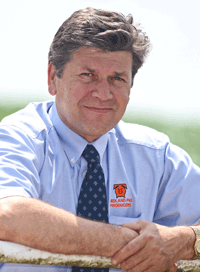FW Awards 2009: Pig Farmer of the Year finalist – Martin Barker

“In the future I won’t need to write any cheques, as we will have over control feed, electricity, fuel and water costs,” says Martin Barker.
This quote sums up the ethos of Midland Pig Producers going forward – sustainability, sustainability, sustainability.
It may seem an extreme statement, but as managing director of Midland Pig Producers (MPP), which consists of 3000 sows across seven farms, there’s no doubt Martin will overcome the ongoing pressures facing the industry.
Taking a business that a year ago was losing thousands of pounds from rising feed and fuel costs, to one that is expected to make £500,000 a year from the sale of biogas alone is astonishing. And it’s a plan based on the analogy of changes in the car industry that will allow this.
“We need some new Toyota plants to replace the old Longbridge plants. This means new high welfare, low environmental impact and odourless facilities producing fertiliser and green energy for the future,” he says.
The model, which will see farms replaced by these new high welfare, environmental systems, is already in progress, with the first 2500-sow site nearing completion.
The new unit in Staffordshire contains a revolutionary underground anaerobic digester, which will use separated slurry from underfloor flushing systems to remove the water before being digested. This means nitrogen is retained and 75% of ammonia is removed.
The resulting product will be a dry, odourless fertiliser, perfect to spread on fields, with the water being recycled. “The environment is becoming the new welfare, so we need to manage it,” says Martin.
After a 40% grant, the biogas plant is costing MPP £140 a pig place, but they predict the pay back period will be as little as two years.
“We are making an average gross margin of £16 a pig, but on the new site the margin will be £53 a pig. This is as well as the £500,000 we expect to make a year from biogas alone,” says Martin.
Feed costs are slashed in the model by providing local farmers with seed and fertiliser on a buy back contract, milling locally grown feed on site – 1500 acres has already been signed up for this.
Martin has also strengthened the links with one of the most vocal welfare groups, by working with them to produce a high welfare system that meets pig’s needs.
The fully slatted system will contain separate areas for dunging, lying and loafing, manipulated by floor design. A straw delivery system will also provide manipulable material for enrichment, with freedom farrowing crates in place for sows.
By 2011 the plan is to have 11,000 sows increasing by 2000 sows a year after this, says Mr Barker.
But, despite the whole business undergoing an overhaul, production figures on existing units are still good. With replacements produced from one multiplication site in the midlands, herd health status has remained sound, after outbreaks of enzootic pneumonia and PRRS in 2003.
At Needwood House Farm, Burton on Trent – the 500-sow unit where Martin is most active – they haven’t had any gilts returning in five years.
“It’s about getting the environment, feed and man right. We don’t settle for second best in any aspect and that’s why we have figures like 15.4 born alive,” he says.
A former pedigree cattle breeder, Martin understands the importance of genetics. “The challenge is genetics going forward because we want a high quality pig with low backfat levels, which is exactly what our customers want. We are currently using Landrace x Large White sows crossed with Hampshire and Pietrain terminal sires.”
But much of the detail on the new sites already exist. Trickle feed systems are used to eliminate competition at the feed face. Paper is also given to sows shortly before farrowing, to help aid nest building behaviour and all this contributes to performance figures such as average daily gain of 738kg from weaning to slaughter, with an FCR of 2.87:1.
MPP sells about 1500 pigs a week, which are marketed through several processors, including Tulip.
“Marketing is critical and by improving welfare and environment on our new units, we could get potentially 10p/kg more a pig for an environmental premium,” says Martin.
What the judges liked
- “Martin is the driving force of a pig business that is setting out to prove UK indoor pig production can be competitive, high welfare and environmentally friendly.”
Three achievements
- Bridging the gap with welfare groups
- Becoming as sustainable as possible
- Attention to detail to get production figures
Farm facts
- 3000 sows across seven farms
- Intensive indoor production
- New 2500-sow unit
- Marketing through Tulip
- More on the Farmers Weekly Awards 2009
- Meet the finalists
